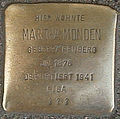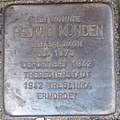M. Glückstadt & Münden

M. Glückstadt & Münden in Hamburg was a leading German publisher for postcards, founded at the end of the 19th century . The company, run by Jewish merchants, was Aryanized in 1939 .
history

The company was originally founded by the Hamburg merchant Moritz Glückstadt (1853–1921), who ran a wholesaler of “ gallantry , short and long-term stores” at Wexstrasse 35 ( 53 ° 33 ′ 3 ″ N, 9 ° 58 ′ 53 ″ E ) . Pipe goods ”entertained. In 1886 he married in the Elbstraßen Synagogue (today: Neanderstraße ) Rosa Münden (1868–1936), who also came from a Jewish family, the daughter of Aron Münden (actually: Aron Anton Münden, born 1867, declared dead in 1945).
After Moritz Glückstadt had founded M. Glückstadt & Münden, the publishing house for " nature-photographed " postcards during the early days of the German Empire and shortly before the turn of the century at the latest , his brother-in-law Daniel Münden (born January 20, 1866 in Hamburg) joined the Publisher, which was moved from the street Alter Steinweg 42/43 ( 53 ° 33 ′ 1 ″ N, 9 ° 58 ′ 52 ″ E ) to Kaiser-Wilhelm-Strasse. In 1909 Münden, who now worked as an amateur photographer with a camera, tripod and magnesium flash for Glücksstadt's company, joined the company as a partner, which in the same year moved from the Kaiser Wilhelm House ( 53 ° 33 ′ 17 ″ in Hamburg Neustadt ) N, 9 ° 58 ′ 51 ″ E ) in Kaiser-Wilhelm-Strasse 93 to the Industriepalast in Caffamacherreihe 1–5 ( 53 ° 33 ′ 16 ″ N, 9 ° 59 ′ 4 ″ E ) .
The focus of the company M. Glückstadt & Münden was less artistic recordings than a selection of motifs as extensive and varied as possible, preferably from hotels in which a wealthy potential clientele stayed. The sales area extended in particular to northern Germany , such as local North and Baltic seaside resorts and the regions of Schleswig-Holstein , Mecklenburg and Brandenburg . The postcards, which were almost automatically requested by travelers and hotel guests, were not printed in-house, but in Leipzig by Glass & Tuscher .
After the death of the company founder Moritz Glückstadt at the beginning of the Weimar Republic , Anton Münden continued to run the company on his own and made a support payment to the widow Rosa Glückstadt that had been contractually agreed between the two owners. In 1925, however, Hedwig Münden received power of attorney for the company, which in 1925 also rented additional office space in the large commercial building with a paternoster elevator, Caffamacherreihe 1-5.
In the Great Depression Mündens commercially trained son Herbert appeared (born in 1905) in the publishing house, less a voluntary professional decision, but more family duty. With his driver's license, he was also allowed to drive the only company vehicle to date: the NSU car was able to transport the photographic equipment that was still heavy at the time and, when not in use, was protected by a garage on Eppendorfer Landstrasse in italics .
In the course of the economic crisis, the demand for postcards and with it the turnover of M. Glückstadt & Münden decreased. At the end of 1930, the previous office space was given up in favor of a smaller two-room apartment at the address Beim Andreasbrunnen 3 ( 53 ° 35 ′ 11 ″ N, 9 ° 59 ′ 6 ″ E ) , in which the father and son Münden now together with one Employees operated the publishing house.
After the " seizure of power " by the National Socialists in 1933, the threat to the company run by Jewish merchants and all their relatives came within reach: In 1935, they moved into the four-story building of the private maternity clinic of the Ernst siblings at the address at Beim Andreasbrunnen 6, diagonally opposite the postcard publisher under the leadership of the NS district leader Johannes Lange, the district office I of the NSDAP , together with the district propagandamt , the district legal office and the district offices for civil servants, educators, technology, public health and others
In the year of the so-called " Reichskristallnacht " in 1938, the owners of M. Glückstadt & Müden were initially deprived of their right to travel. As a result, customer service was no longer possible and the company was weakened economically. In the course of the November pogroms , the younger publisher's owner Herbert Münden was arrested in the apartment of his in-laws Aron and Hedwig Reginbogin at what was then Hansastraße 55 in the Hamburg district of Harvestehude . Later, his wife and a sister were able to pick up Herbert Münden's valuables at a police station - presumably in the federal highway. Herbert Münden had been deported from Hamburg to the Sachsenhausen concentration camp , but was released six weeks later on December 23, 1938 after he had given a written commitment to "keep silent about the exact circumstances of the detention".
Just a few months later, the postcard publisher, which had been deliberately weakened economically during the “ Third Reich ”, was “Aryanized” in 1939: The “ Aryan ” businessman and “specialist subgroup leader” Hans Andres , who had specialized in the regional market since 1926, bought it for just 3000 Reichsmarks Postcard publishing in the Greater Hamburg area together with the photographer Hans Hartz (1902–1971) ran the company M. Glückstadt & Münden. For this he received "[...] estimated" around 17,000 photo originals and negatives, of which around 2000 were current from the previous two years. In addition to the good reputation and customer data of the publishing house, which was previously run by Jewish entrepreneurs, he also received, for example, a typewriter from the Mercedes brand, a "Camera 4.5 Zeiss Tessar 10x15 with various lenses" and a warehouse with around 500,000 already completed postcards . After transfer to the ownership of Andres, the company M. Glückstadt & Münden was deleted from the commercial register on October 4, 1939 . The stamped note “Im Aufgebot am” and the inserted date stamp “23. June 1939 “document the administrative forced sale of the company.
Also in 1939 and still in the spring , the henchmen of the unjust state also expropriated the private property of the Münden family: First, the family had to deliver gold, silver and jewelry to state collection points, then also to pay the Jewish property tax that had just been created . When the Nazi foreign exchange office wanted to initiate further "security measures" against the Mündens to freeze assets in March 1939, the family was already so ruined that these measures were discontinued because they were insignificant .
Herbert Münden and his wife Ellen, née Reginbogin, had already emigrated to La Paz / Bolivia via Amsterdam, London and Cuba at the beginning of 1939. Despite multiple attempts, his parents were unable to follow them: the married couple Anton and Hedwig Münden were deported to the Theresienstadt ghetto on July 15, 1942 , and from there on September 23, 1942, to the Treblinka extermination camp . Her belongings that were forcibly left behind in her last Hamburg apartment at Frickestrasse 24 were "confiscated" by the state and auctioned off by the auctioneer Carl F. Schlueter for a total of 600 Reichsmarks.
After the end of World War II and the founding of the Federal Republic of Germany , the Hamburg District Court declared Anton and Hedwig Münden to be dead in 1949: "The date of death was set as May 8, 1945."
Hans Andres' publisher, however, is said to have published postcards until the 1970s, later under the brand names "AH, ANCO and ANCO-LUX". In addition, a branch is said to have existed in Berlin .
Stumbling blocks
In memory of the Münder family and as part of Hamburg's culture of remembrance , the following stumbling blocks were laid in the Hanseatic city:
- at Agnesstrasse 46 in Hamburg-Winterhude for the family members Daniel, Martha and Gerhard Münden who were deported from the Netherlands in 1943;
- in Grindelallee 153 in Hamburg-Rotherbaum for Max and Martha Münden
Stumbling block for Max ...
and Martha at Grindelallee 153 in Hamburg-Rotherbaum ,
Daniel at Agnesstrasse 46 in Hamburg-Winterhude ;
for Hedwig in front of the house at the Andreasbrunnen 3 in Hamburg-Eppendorf ,
literature
for the CVs of the Daniel, Martha and Gerhard Münden families:
- Ulrike Sparr (Ed.), Rita Bake , Beate Meyer (Red.), Björn Eggert, Ulf Bollmann et al. : Stumbling blocks in Hamburg-Winterhude. Biographical search for traces. Published by the State Center for Political Education Hamburg, Hamburg 2008, ISBN 978-3-929728-16-3 ; Table of contents .
Web links
- Glückstadt Münden on the zeno.org site
- Björn Eggert: Aron Anton Münden * 1867 / at Andreasbrunnen 3 (Hamburg-Nord, Eppendorf) on the stolpersteine-hamburg.de page
Remarks
- ↑ In contrast, the German Historical Museum suggests 1928 as the founding date of the joint venture between Hans Andres and Hans Hartz
Individual evidence
- ↑ a b Compare, for example, the postal date of 1901 on the address side of the postcard from the Hamburg publishing house, consecutively numbered with the number 377 as a moonlight card
- ↑ a b c d e f g h i j k l m n o Björn Eggert: Aron Anton Münden * 1867 / Beim Andreasbrunnen 3 (Hamburg-Nord, Eppendorf) on the page stolpersteine-hamburg.de
- ^ NN : Hans Hartz (1902-1971) on the website of the German Historical Museum (DHM), last accessed on August 17, 2016
- ↑ Thomas Pilz (responsible): Hans Andres / Hans Andres, Hamburg on the private side under the working title “ Güstrow . Historical views on old postcards and photos ”on the guestrow-history.de page , last accessed on August 17, 2016








